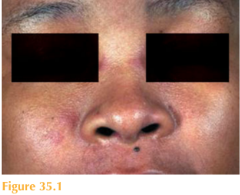History
A 23-year-old African Caribbean patient presents with an acute-onset facial rash. She has no rash elsewhere and no previous history of skin problems. She had taken an antihis-tamine for suspected allergy reaction as her face had become slightly swollen and red. Her family had become increasingly worried and took her to the local accident and emergency department. During her assessment she complained of a two-week history of general malaise, fatigue, fever and weight loss. On a systems review she admitted to having experienced intermittent joint pains involving her hands and knees.
Examination
She has a subtle erythematous confluent eruption present over her cheeks and nose which is ill-defined and slightly oedematous (Fig. 35.1); there is minimal scaling. The rest of her skin examination is normal including the scalp and nails, however she does have two ulcers present on her oral mucosa. She has tenderness in the small joints of her hands. Her temperature is 38.4 °C.


Questions
• What is the unifying diagnosis?
• What other cutaneous signs may be seen?
• Which other organ systems can be involved?
This type of clinical presentation can be a diagnostic challenge. Patients presenting with fever, malaise and weight loss may be suspected of suffering from systemic infections or malignancy. However, this patient had a facial rash and arthritis which should raise the possibility of a connective tissue disease. Consequently this patient was diagnosed with a serious multisystem autoimmune disease – namely systemic lupus erythematosus (SLE).
Patients with acute SLE classically develop a ‘butterfly rash’ over their cheeks and nose which is an erythematous, confluent, oedematous/macular eruption in the shape of a but-terfly. Cutaneous lesions are found in 75 per cent of patients, including urticaria, bullae, photosensitivity, nailfold telangiectasia, calcinosis, vasculitis, Raynaud’s phenomenon, diffuse/patchy alopecia and mouth ulcers. Patients may present acutely unwell with fever, weight loss and malaise. SLE is more common in women than men and is more common in African Caribbeans.
Multisystem involvement with serological or haematological abnormalities must be dem-onstrated to make the diagnosis of SLE within the framework of the revised American Rheumatism Association (ARA) criteria for the classification of SLE (see Table 35.1). Virtually any organ system can be affected by SLE including musculoskeletal (arthralgia, arthritis, myopathy) and renal, pericarditis, pneumonitis, hepatosplenomegaly, lymphad-enopathy and peripheral neuropathies. Central nervous system (CNS) involvement can occur leading to seizures and psychiatric disturbances.
Relevant investigations include a skin biopsy for histology and immunofluorescence where there is demonstration of IgG, IgM and C3 in a band-like pattern along the der-mal–epidermal junction. Anti-nuclear antibodies (ANA) are positive in over 90 per cent of cases. Further positive autoantibodies including anti-double strand DNA and extractable nuclear antigen, anticardiolipin autoantiboides (lupus anticoagulant) may also be seen. Blood tests may also reveal a normocytic, normochromic anaemia, lymphopenia, throm-bocytopenia, raised ESR and low complement levels. Patients should be investigated for any concurrent infections to which they are susceptible.
Management of SLE during an acute attack can be challenging. Patients often need admission to hospital for rest, investigations and systemic corticosteroids. If there is obvious renal and CNS involvement or significant systemic upset, then high-dose pulsed methylprednisolone may be required. When patients are stable they should be advised about photoprotection. Long-term management may include hydroxychloroquine for cutaneous disease and steroid-sparing immunosuppressants such as azathioprine, myco- phenolate mofetil and cyclophosphamide.
KEY POINTS
• Systemic lupus erythematosus (SLE) is a serious multisystem autoimmune disease affect-ing mainly females.
• Clinical presentations of acute SLE may be misdiagnosed as infections/malignancy.
• Cutaneous lesions are found in 75 per cent of patients with SLE.
need an explanation for this answer? contact us directly to get an explanation for this answer